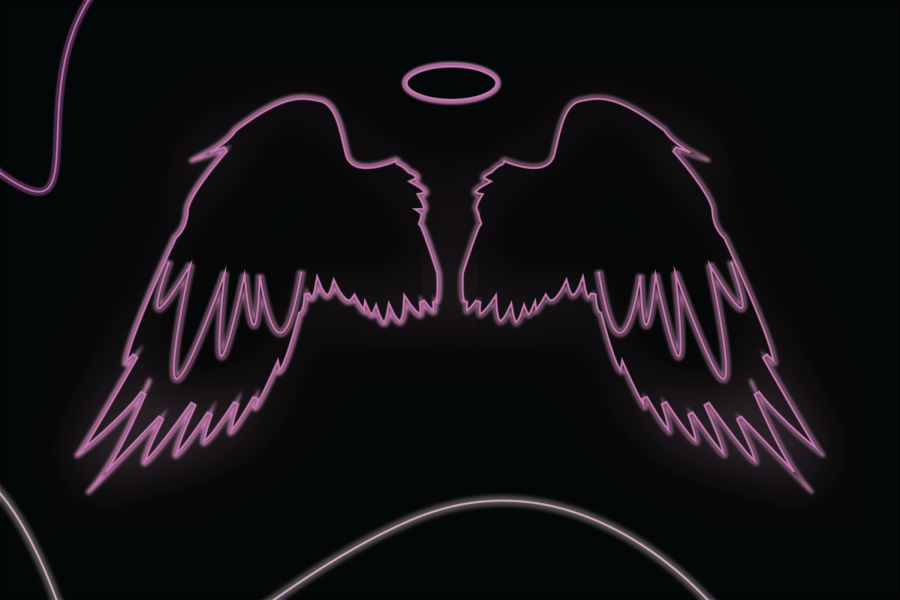REVIEW: 30 years on, Angels in America still strikes a chord
Despite “Angels in America” clearly capturing the politics of the 1980s, its messaging and themes carry well into the 21st century. Graphic by Brennan Eberwine
November 9, 2022
In the early 21st century, the most profound change to the world has been the condensing of life into smaller and smaller moments. The internet rules our lives with trends and these trends can die the same week they were created. Controversy and its backlash on Twitter crash and recede like tidal waves, and one of the most defining social medias of this modern era has become a platform dedicated to the smallest videos that keep your attention for as long as possible.
As a result, describing all that has happened feels like a monumental, almost impossible task. Therefore, we have to look towards art that will pare down life into something tangible that captures the feeling of being alive at a certain moment in time; the feeling of living in a modern era.
Many pieces of art have attempted to do exactly that:: from the frenetic horror of suffering in a world at war portrayed in 1937’s “Guernica” to the feeling of infinity and absurdity seen in 2022’s “Everything, Everywhere, All At Once”. Most art tries to focus on the miniscule but some looks at the big picture.
However, Tony Kushner’s play, “Angels in America: A Gay Fantasia on National Themes” may take this idea to the next level. eleased in two parts from 1991-1992, he play is ostensibly about the AIDS crisis and how it specifically unwravels two characters who lead very different lives but succumb to the same sickness. However, only characterizing a play that is split into two parts and is over 8 hours in length as just an “AIDS play” is an injustice. “Angels in America” sprawls so long to try and understand why we keep going, even under increasingly disparate circumstances. 30 years later, it still captures so much truth of the American experience.
In the notes of the book version of “Angels in America”, Kushner writes “Millennium Approaches and Perestroika are two parts of a single play, but at the same time they’re two rather different plays”. This is true in that the first part is shorter and has a much different tone. The narrative progresses (even if in a depressing way) and the characters likewise move forward. The two characters diagnosed with AIDS, Roy Cohn and Prior Walter, bide their time as they seemingly just wait to die. This waiting in futility colors a lot of AIDS art in the time before living with the disease became possible. In Larry Kramer’s 1985 play “The Normal Heart” the plot is a semi-autobiographical account of the founding of Kramer’s organization “Gay Men’s Health Crisis” and the tension in the board of directors over what the best course of action is. At the same time Ned Weeks (based on Kramer himself) is watching his partner die of the very disease he’s fighting against.
Perestroika on the other hand seems to freeze the characters in place as months go by They are left to ruminate on sickness, hope, faith and religion before a rhapsodic ending. Prior Walter is in intense isolation, roaming and searching for answers. The second part’s length exacerbates this feeling and allows it to fester. The restlessness in the face of the inevitable is the main feeling through its five acts.
Though Kushner’s play is very much of its time, millennium has in fact approached, and the issues that plagued America in 1992 seem to have only intensified in the past few decades. Cohn’s stroking of power to get on the antiviral medication azidothymidine (AZT), what was at the time only in medical trials and only available to maybe dozens of people out of the thousands dying, exemplifies the worst practices of the American healthcare system that still are perpetuated to this day.
Roy Cohn, a real lawyer who was a part of Joseph McCarthy’s legal counsel during the Red Scare, is still one of the best characterizations of naked power put to paper because of his indifference to the law, something that has become in vogue as of late in politics. And with Cohn actually being Donald Trump’s personal attorney for a time, the play sometimes feels downright prophetic.
But “Angels in America”’s ruminations on the politics of the late 1980s are only the setup to its real question: how does one continue on in the face of so much tragedy? This is what the characters wrestle with throughout mainly Perestroika. Both Prior and Roy know they will die, but if you know the end how can you continue?
The truth is staying paralyzed in a moment and in denial is what kills. Out of all the characters, Roy Cohn has the greatest access to treatments, doctors, and power, but dies before the play ends because he doesn’t change. He’s chained to his past and his power, in denial of the future until it’s undeniable. He dies in a hospital bed with only a ghost of his past (who happens to be the actual ghost of Ethel Rosenberg, a communist he prosecuted to execution in 1953.)
Prior also spends much of the play alone, abandoned by his lover Louis, a flawed, neurotic pontificator on leftist politics, wrestling with death and what he should do. Unlike Roy, he’s only thirty years old; there’s no past to dwell on, there’s no future either. Supernaturally, he’s visited by an angel who gives him a prophecy: humans should stay put, not move.
“You Do not Advance. You only Trample,” The angel says ominously at the beginning of Act two.
A prophecy telling humans to stop moving feels almost uncanny in 2022 after the height of a pandemic (something that could also be described as a “plague”). But the angels say only suffering comes from truly living, and that’s what a lot of life feels like in this millennium. The aforementioned overload of all information everywhere. Of sickness, death, lies and politics. It could be easier to wax nostalgic for the past and remove ourselves from the present. But that isn’t living, not living is death.
So the thesis of “Angels in America” is that to keep living even in the face of cruelty is how to beat cruelty, a message desperately needed and more relevant than ever in 2022.
There may never be a piece of art that can fully capture the zeitgeist of a moment in time, but “Angels in America”’s message continues to endure. Even if America’s politics have morphed into a brand new slate of problems, the core issues remain. There are no easy answers in solving problems, there is no singular solution. But searching for a better America is necessary.









